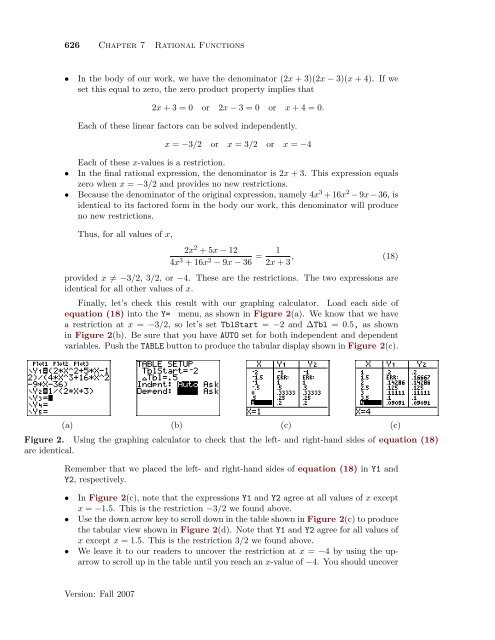Chapter 7 Rational Functions - College of the Redwoods
Chapter 7 Rational Functions - College of the Redwoods
Chapter 7 Rational Functions - College of the Redwoods
Create successful ePaper yourself
Turn your PDF publications into a flip-book with our unique Google optimized e-Paper software.
626 <strong>Chapter</strong> 7 <strong>Rational</strong> <strong>Functions</strong><br />
• In <strong>the</strong> body <strong>of</strong> our work, we have <strong>the</strong> denominator (2x + 3)(2x − 3)(x + 4). If we<br />
set this equal to zero, <strong>the</strong> zero product property implies that<br />
2x + 3 = 0 or 2x − 3 = 0 or x + 4 = 0.<br />
Each <strong>of</strong> <strong>the</strong>se linear factors can be solved independently.<br />
x = −3/2 or x = 3/2 or x = −4<br />
Each <strong>of</strong> <strong>the</strong>se x-values is a restriction.<br />
• In <strong>the</strong> final rational expression, <strong>the</strong> denominator is 2x + 3. This expression equals<br />
zero when x = −3/2 and provides no new restrictions.<br />
• Because <strong>the</strong> denominator <strong>of</strong> <strong>the</strong> original expression, namely 4x 3 + 16x 2 − 9x − 36, is<br />
identical to its factored form in <strong>the</strong> body our work, this denominator will produce<br />
no new restrictions.<br />
Thus, for all values <strong>of</strong> x,<br />
2x 2 + 5x − 12<br />
4x 3 + 16x 2 − 9x − 36 = 1<br />
2x + 3 , (18)<br />
provided x ≠ −3/2, 3/2, or −4. These are <strong>the</strong> restrictions. The two expressions are<br />
identical for all o<strong>the</strong>r values <strong>of</strong> x.<br />
Finally, let’s check this result with our graphing calculator. Load each side <strong>of</strong><br />
equation (18) into <strong>the</strong> Y= menu, as shown in Figure 2(a). We know that we have<br />
a restriction at x = −3/2, so let’s set TblStart = −2 and ∆Tbl = 0.5, as shown<br />
in Figure 2(b). Be sure that you have AUTO set for both independent and dependent<br />
variables. Push <strong>the</strong> TABLE button to produce <strong>the</strong> tabular display shown in Figure 2(c).<br />
(a) (b) (c) (c)<br />
Figure 2. Using <strong>the</strong> graphing calculator to check that <strong>the</strong> left- and right-hand sides <strong>of</strong> equation (18)<br />
are identical.<br />
Remember that we placed <strong>the</strong> left- and right-hand sides <strong>of</strong> equation (18) in Y1 and<br />
Y2, respectively.<br />
• In Figure 2(c), note that <strong>the</strong> expressions Y1 and Y2 agree at all values <strong>of</strong> x except<br />
x = −1.5. This is <strong>the</strong> restriction −3/2 we found above.<br />
• Use <strong>the</strong> down arrow key to scroll down in <strong>the</strong> table shown in Figure 2(c) to produce<br />
<strong>the</strong> tabular view shown in Figure 2(d). Note that Y1 and Y2 agree for all values <strong>of</strong><br />
x except x = 1.5. This is <strong>the</strong> restriction 3/2 we found above.<br />
• We leave it to our readers to uncover <strong>the</strong> restriction at x = −4 by using <strong>the</strong> uparrow<br />
to scroll up in <strong>the</strong> table until you reach an x-value <strong>of</strong> −4. You should uncover<br />
Version: Fall 2007

















